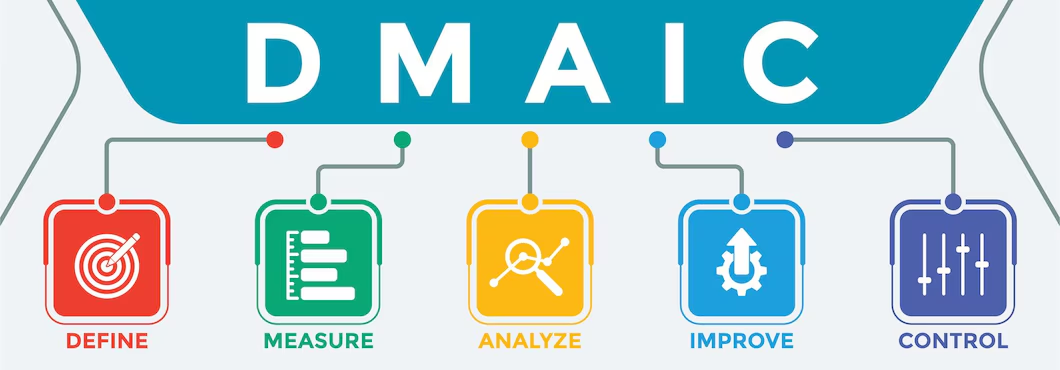1. What is DMAIC?
DMAIC is a data-driven, structured problem-solving methodology used in Lean Six Sigma to improve processes. It stands for Define, Measure, Analyze, Improve, and Control.

2. What is the DMAIC method??
The DMAIC method is a systematic, structured approach to process improvement. It involves five phases: Define, Measure, Analyze, Improve, and Control, each focusing on different aspects of process enhancement.
3. What are the 5 phases of the DMAIC Process?
Define: Identify the problem, project goals, and customer requirements.
Measure: Collect data to establish a baseline for current process performance.
Analyze: Identify root causes of the problem using data analysis.
Improve: Develop and implement solutions to address root causes.
Control: Ensure that improvements are sustained over time.
4. Is Lean Six Sigma the same as DMAIC?
No, Lean Six Sigma is a broader methodology that combines Lean and Six Sigma principles to improve process efficiency and quality. DMAIC is a core process improvement framework within Lean Six Sigma.
5. What are the 5 steps of Six Sigma?
The five steps of Six Sigma are represented by the DMAIC framework: Define, Measure, Analyze, Improve, and Control.
6. What tool is DMAIC?
DMAIC is not a single tool but a structured methodology that utilizes various tools and techniques, such as process maps, control charts, fishbone diagrams, and FMEA, to achieve process improvement.
7. Why use the DMAIC process?
The DMAIC process provides a structured, data-driven approach to problem-solving, ensuring that solutions are effective and improvements are sustained. It helps organizations enhance quality, reduce costs, and meet customer needs.
8. What is the difference between DMAIC and PDCA?
DMAIC (Define, Measure, Analyze, Improve, Control) is a structured Six Sigma methodology focused on process improvement. PDCA (Plan, Do, Check, Act) is a simpler iterative method used for continuous improvement and problem-solving.
9. What are the 5 whys in DMAIC?
The 5 Whys is a root cause analysis tool used in the Analyze phase of DMAIC. It involves asking "Why?" multiple times (typically five) to drill down into the root cause of a problem.
10. What phase of DMAIC is FMEA?
Failure Modes and Effects Analysis (FMEA) is typically used in the Analyze and Improve phases of DMAIC to identify potential failure modes, their causes and effects, and prioritize actions to mitigate risks.
11. DMAIC in Project Management
DMAIC, a fundamental methodology in Lean Six Sigma, can significantly benefit project management by providing a structured approach to process improvement. The Define phase involves clearly outlining project goals, objectives, and scope, as well as identifying stakeholders and their requirements. This sets a solid foundation for the project and ensures alignment with stakeholder expectations.
In the Measure phase, project managers establish key performance indicators (KPIs) and collect data to understand the current state of the project. This data serves as a baseline for measuring improvements and identifying areas for enhancement. The Analyze phase involves a detailed examination of the collected data to identify root causes of issues and inefficiencies. Tools like fishbone diagrams and Pareto charts can help pinpoint these causes.
With a clear understanding of the problems, the Improve phase focuses on developing and implementing solutions. This may involve process redesign, resource reallocation, or the introduction of new tools or technologies. Pilot tests are often conducted to validate these solutions before full implementation.
The Control phase ensures that improvements are sustained over time. This involves establishing control measures, developing standard operating procedures (SOPs), and implementing monitoring mechanisms. Continuous review and refinement of processes are essential to maintain efficiency and effectiveness. Overall, DMAIC provides project managers with a systematic approach to identify, analyze, and improve project processes, leading to better project outcomes and stakeholder satisfaction.
12. DMAIC vs. DMADV
DMAIC (Define, Measure, Analyze, Improve, Control) is used for improving existing processes, while DMADV (Define, Measure, Analyze, Design, Verify) is used for designing new processes or products. Both are part of the Six Sigma methodology.